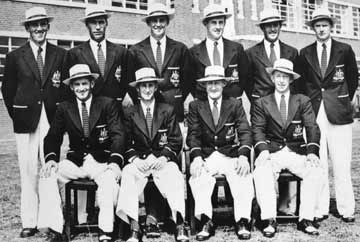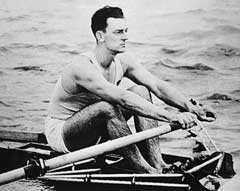Olympic Games—London 1948
A small number of images of the Australian team at these Games can be found through this link to the Australian Rowing Images website.
This was the first post war Olympic Games and was held in London as Helsink (which had been allotted the 1940 Games but which was aborted by the war) was not ready to conduct the Games. Rowing took place on the Henley course which was both widened and shortened to 1850 metres to accommodate three crews across.
This was also the first Games where the team flew to London. The Australian Olympic Committee website reported that: The 63-member team flew on four Constellation flights which took four days and required nine stops for fuel. Qantas started their long association with the Australian Olympic movement.

Back row: Ted Bromley, Spencer Grace, Merv Wood, Bruce Goswell, Hugh Lambie, Colin Smith
Front row: Jack Webster, Tom Darcy, Ray Todd, Wally Lambert
Selection
The Australian Amateur Rowing Council decided that an eight would not be sent due to training and financial difficulties but that a test race would be held on 3rd January 1948 for fours representing each State and that a sculler would be sent.
(As an aside, the NSW and Victorian Associations also sent lightweights fours to this regatta for a special challenge race. This was to be the forerunner of the Interstate Lightweight Four Championship which commenced 10 years later in 1958. The winning crew from NSW won easily and comprised Bow: Bert Harding, 2: Doug McCray, 3: Pat McCray, Str: Kevin Bond, Cox: W Kerr and coach K Manttan.)
The selected coxed four won the test race at Ballarat comfortably. Ray Todd, the sole selector for this team, submitted to the AOF the following recommendations and gradings: 1st coxed four, 2nd Mervyn Wood, 3rd coxless pair.
The AOF accepted the recommendations on the condition that Bromley and Grace make the final of the Silver Goblets at Henley Royal Regatta and this to be at their expense. The pair did this and their selection was confirmed.

Merv Wood
There were neither test races nor even any regatta races in pairs at that time so the initial selection of Bromley and Grace was on their rowing records. It was therefore not surprising that the AOF placed this condition on them.
Australian Team
Men's Single Scull - Gold
- Mervyn T Wood (NSW)
Men's Coxless Pair – Eliminated in semi final
- Str: F Spencer Grace (NSW)
- Bow: Edward R Bromley (NSW)
Men's Four with Cox - Eliminated in repechage
- Bow: Jack W Webster (VIC)
- 2: Colin D Smith (VIC)
- 3: Hugh T Lambie (VIC)
- Str: Walter J Lambert (VIC)
- Cox: Tom Darcey (VIC)
- Coach : W Ray Todd (VIC)
- Reserves: Bruce H Goswell (NSW)
- Owen Ruffles was also selected but later withdrew due to lack of funding for two reserves.
Sole selector: Ray Todd (VIC)
Racing
Men's Single scull
E1: 1st AUS, 2nd URU, 3rd SAF
E2: 1st GBR, 2nd SUI, 3rd YUG
E3: 1st USA, 2nd SWE, 3rd ESP
E4: 1st FRA, 2nd ARG, 3rd EGY
E5: 1st ITA 2nd GRE
R1: 1st ARG, 2nd ESP, 3rd GRE
R2: 1st URU, 2nd SUI, 3rd SWE
R3: 1st SAF, 2nd EGY, 3rd YUG
SF1: 1st ITA, 2nd ARG, 3rd SAF
SF2: 1st URU, 2nd USA, 3rd GBR
SF3: 1st AUS, 2nd FRA
Final: 1st Mervyn Wood (AUS) 7:24.4, 2nd Eduardo Risso (URU) 7: 38.2,
3rd Romolo Catasta (ITA) 7:51.4 (14 scullers)
Wood was in a class of his own and won by 5 lengths.
Men's Coxless Pair
E1: 1st SUI, 2nd AUS, 3rd DEN
E2: 1st GBR, 2nd ITA, 3rd ARG
E3: 1st AUT, 2nd USA, 3rd SWE
E4: 1st BRA, 2nd BEL, 3rd FRA
R1: 1st ITA, 2nd USA, 3rd FRA
R2: 1st DEN, 2nd BEL, 3rd ARG
R3: 1st AUS, 2nd SWE
SF1: 1st SUI, 2nd AUS, 3rd AUT
SF2: 1st ITA, 2nd DEN
SF3: 1st GBR, 2nd BRA
Final: 1st GBR (John Wilson & William Laurie) 7:21.1, 2nd SUI 7:23.9,
3rd ITA &:31.5 (12 crews)
The performance of this crew was impressive as Grace was ill and in hospital up to a matter of a few days prior to the final. The final was won by Wilson and Laurie (GBR) who were best friends who joined the Colonial Service and were sent to the Sudan. Returning to London on leave in 1938, they entered and won the pairs. Then they went back to the Sudan and did not touch an oar for ten years. In 1948, they found themselves in Britain on leave and took up rowing. After six weeks training, they entered and won Henley again. This gave them selection into the British team. The "Desert Rats", as they were called, took the lead at the 1150 metre mark and fought off a late challenge from the Kalt brothers from Switzerland to take gold.
Men's Coxed Four
E1: 1st POL, 2nd GRE
E2: 1st HUN, 2nd YUG
E3: 1st ITA, 2nd AUS
E4: 1st USA, 2nd GBR
E5: 1st AUT, 2nd CUB
E6: 1st DEN, 2nd NOR
E7: 1st SUI, 2nd ARG
E8: 1st FRA 2nd FIN
R1: 1st FIN, 2nd AUS
R2: 1st NOR, 2nd YUG
R3: 1st CUB, 2nd GRE
R4: 1st GBR, 2nd ARG
QF1: 1st ITA, 2nd NOR
QF2: 1st SUI, 2nd AUT
QF3: 1st USA, 2nd FIN
QF4: 1st DEN, 2nd POR
QF5: 1st FRA, 2nd CUB
QF6: 1st HUN, 2nd GBR
SF1: 1st USA, 2nd FRA
SF2: 1st DEN, 2nd HUN
SF3: 1st SUI, 2nd ITA
Final: 1st USA (Warren Westlund, Robert Martin, Robert Will, Gordon Giovanelli, Allen Morgan) 6:50.3, 2nd SUI 6:53.3. 3rd DEN 6:58.6 (16 crews)
This was a disappointing result with the four departing from the event in the repechage.
Men's Double scull
1st GBR (Richard "Dickie" Burnell & Bertram "Bert" Bushnell, finishing coach Jack Beresford) 6:51.3, 2nd DEN 6:55.3, 3rd URU 7:12.4 (15 crews)
Men's Coxed Pair
1st DEN (Finn Pedersen, Tage Henriksen, Carl-Ebbe Andersen) 8:00.5, 2nd ITA 8:12.2, 3rd HUN 8:25.2 (9 crews)
Men's Coxless Four
1st ITA (Giuseppe Moioli, Elio Morille, Giovanni Invernizzi, Franco Faggi) 6:39.0, 2nd DEN 6:43.5, 3rd USA 6:47.7 (10 crews)
Men's Eight
1st USA (Ian Turner, David Turner, James Hardy, George Ahigren, Lloyd Butler, David Brown, Justus Smith, John Stack, Ralph Purchase) 5:56.7, 2nd GBR 6:06.9, 3rd NOR 6:10.3. (12 crews)
The eights race was won by the Americans who won each race by at least 10 seconds. This University of California at Berkeley crew had obviously faced its biggest challenge in getting selected through very tight racing in the American selection process. They won the American test race by 0.1 seconds.

